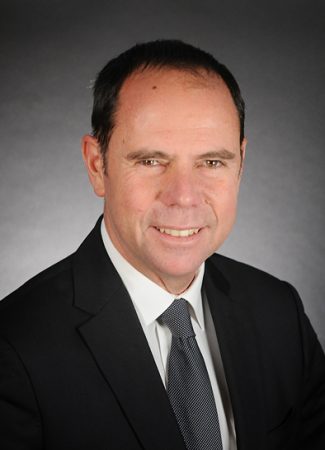Key Insights from the French Market Analysis
Analysis of the French energy market is key to understanding the dynamics and trends affecting the sector both locally and internationally. In this detailed analysis, we address the important factors influencing energy prices, supply and demand, and the latest regulatory policies. This comprehensive overview will allow you to keep up to date with weekly changes and anticipate possible market variations, both in France and in other relevant markets such as Spain.
Table of Contents
November 2025
Key figures of the month
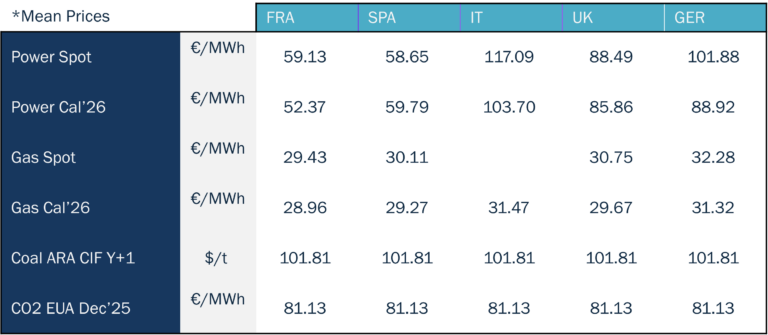
Energy demand and generation mix
In November 2025, electricity consumption in France during peaks in demand averaged 61 GW, 1% higher than November 2024. Additionally, the peak in electricity demand during this month was reached on Friday 21 November, with 75.9 GW, well above the levels seen the previous month (57.9 GW). This peak corresponds to the arrival of the polar air mass that affected the country during the week of 17 to 24 November. Temperatures remained below seasonal norms and snow fell as far as the lowlands on the weekend of 22 and 23 November.
In terms of the generation mix, average nuclear generation in November was 48.8 GWh. The average maximum output was reached end of the month (52.1 GWh), and the average minimum output was reached the first day of the month (43 GWh). Strong nuclear production is contributing to comfortable supply conditions. The last week of the month, 7 out of 57 reactors in the French nuclear fleet were on scheduled shutdown. As part of the post-Arenh scheme for sharing revenue from the operation of existing nuclear power plants by EDF, a draft decree sets the threshold rates for the first three-year period from 1 January 2026 to 31 December 2028 at €78/MWh and €110/MWh respectively. Moreover, mid-November, la cour des Comptes announced that “continuing to operate the existing nuclear fleet for up to 50 years, then 60 years, could prove particularly profitable for EDF”. The additional cost associated with this extension is estimated at €51/MWh (in 2023 euros). The institution considers this cost to be “very competitive compared to the construction of new electricity generation capacity”, whether renewable or not.
In the matter of renewable energy sources, as you can see from the graph, hydro production comes second in the total energy mix, for the first time since March-25, representing a 15.2% out of the total production and first in the renewable energy category. Hydroelectric stocks decreased from 2,285 GWh (at the end of November) to 2,498 GWh (at the end of October), below last year’s level (2,782 GWh). Wind energy comes third in the total energy mix, representing 12% (in line with last month levels – 10.1 GWh). Finally, photovoltaic production has decreased significantly (8.3 GWh); we are entering the least sunny period of the year (November to February). We can expect these levels of solar production over the coming months.
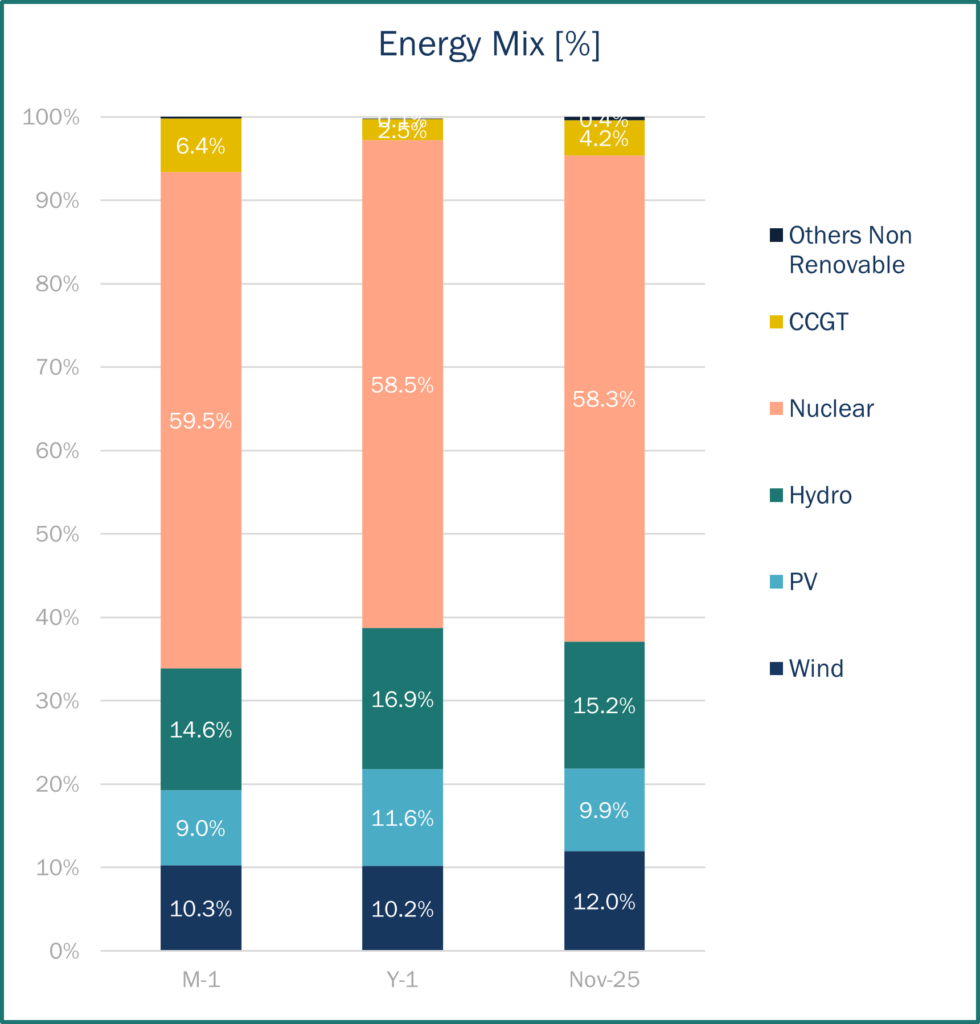
Source: Haya Energy Solutions
Energy prices & market panorama
Firstly, average electricity prices for day-ahead base contracts in France reached €61.5/MWh, 74% lower to November-24’s levels (€106.84/MWh). As the graph shows, prices fluctuated considerably throughout the month with the minimum price for the day-ahead base contract being €21.47/MWh on 4th November, and the maximum price €112.72/MWh on 20th November. In France consumption is highly temperature-sensitive however, during November, temperatures have remained slightly above seasonal norms, reducing power demand. This not-so-cold weather, combined with solid wind output and good nuclear availability, keeps French power prices under strong downward pressure. Prices were further weighed down by reports that RTE is preparing a revised 2035 demand forecast roughly 9% lower than previously expected. Meanwhile, discussions in the national assembly about potentially lowering renewable targets in the next PPE had only a negligible market impact.
Regarding imports and exports, in November, France was in a position of net exporter with all its borders, except Spain. The maximum level of exports for the month was 18,596 MW.
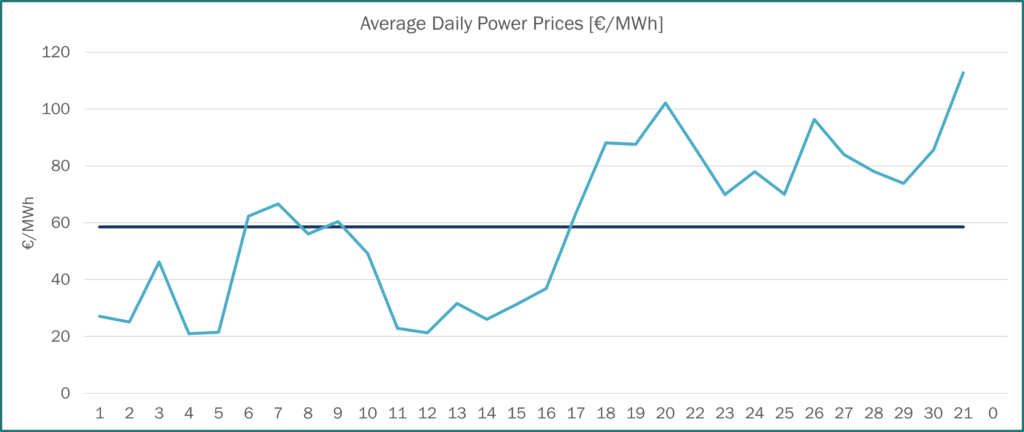
Source: Haya Energy Solutions
Secondly, gas prices, the TTF spot contract closed at €28.6/MWh on 28th November. During the month, spot TTF prices varied slightly between €28.6 and €31.9/MWh. Since February-25, TTF spot contract prices are in a downward tendency (except from May to June). Its lowest price since the beginning of the year has been reach at the end of November due to robust LNG supply, good levels of the gas storages and above-average seasonal temperatures reducing heating demand. Moreover, Asian LNG demand remains subdued, not only in China but also across several other regional buyers, limiting European competition for cargoes. In addition, market sentiment around the possibility of progress toward a peace agreement in the Ukraine conflict contributed to reducing pressure on prices.
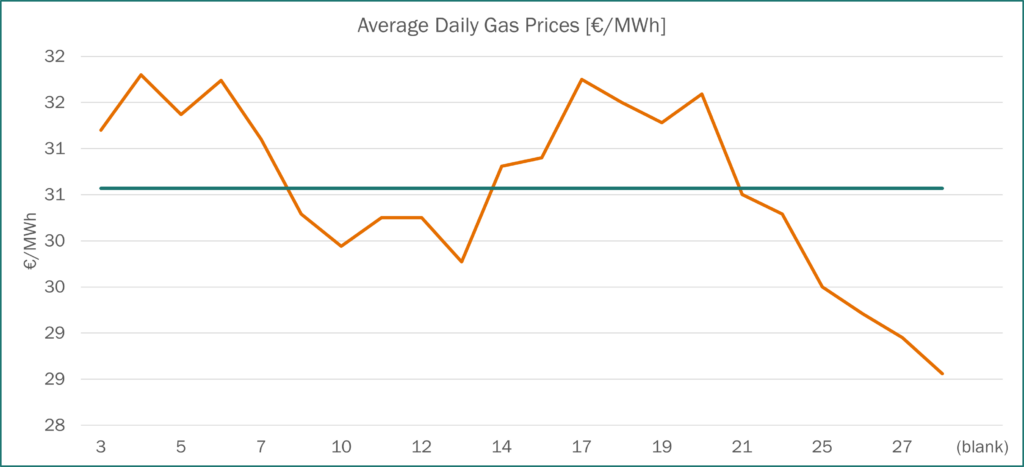
Source: Haya Energy Solutions
EU gas stocks are 75.35% full on average, compared to 95.2% last year. France’s gas storage levels are at 81.97%, below 2024 (95.2%). It is worth noting that since July 2025, the European Parliament has relaxed the 90% minimum storage requirement, allowing Member States to reach this target at any point between 1st October and 1st December each year. Once the threshold is achieved, it is no longer mandatory to maintain it until year-end, providing countries with greater operational flexibility.
Market trends and futures
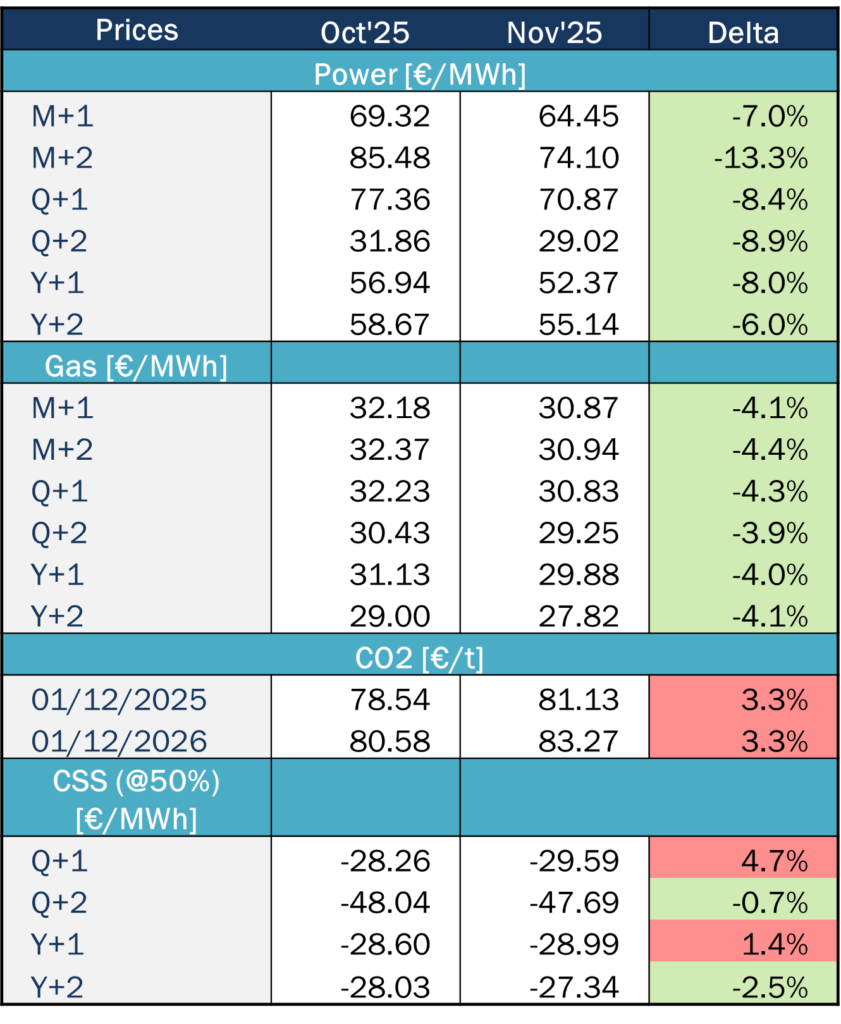
Source: Haya Energy Solutions
In November, power prices decreased considerably across all maturities, with the most significant drops occurring in medium-term contracts like Q+2 which fells by around 13%. The French calendar curve is in clear contango, with Cal-26 trading around €52.37/MWh and Cal-27 at €55.14/MWh, whereas other Western European markets remain in backwardation. French calendar prices have reached its lowest level since last years.
Similarly, gas prices fell, by approximately 4% across the curve. Cal 2026 gas prices falling below €30/MWh underscore the market’s expectation that increasing LNG supply will exert significant bearish pressure in the coming years.
Carbon dioxide (CO₂) prices experienced an increase, rising about 3% for both 2025 and 2026 maturities compared to the previous month. CO₂ futures reached their highest level since early February. This combination sent mixed signals regarding price formation: lower gas costs provided some relief for gas-fired technologies, but the rise in carbon prices increased costs for the most carbon-intensive plants. This could contribute to rise electricity prices in many European markets. Moreover, the upward momentum was also supported by continued market attention on Germany’s plan to lower power costs for industry, a measure viewed as ultimately supportive for industrial emissions and therefore bullish for carbon prices.
On the oil side, OPEC+ announced a pause in supply growth during Q1-26. The cautious adjustment reflects expectations of weaker seasonal demand early next year and concerns about a potential oversupply. Furthermore, at the end of the month oil prices eased as markets focused on signs of progress in negotiations over a Russia-Ukraine peace proposal. At the end of November, it seems unlikely that significant progress will be made, keeping oil markets in a wait-and-see mode.
Regulation
As part of the post-Arenh scheme for sharing revenue from the operation of existing nuclear power plants by EDF, a draft decree sets the threshold rates for the first three-year period from 1 January 2026 to 31 December 2028 at €78/MWh and €110/MWh respectively.
It is worth noting that November 2025 marked the second month of implementation of the quarter-hour pricing system in the French electricity market, transitioning from 24 hourly prices per day to 96 quarter-hourly prices. This new methodology has enabled greater price granularity and a more accurate response to real-time supply and demand fluctuations.



